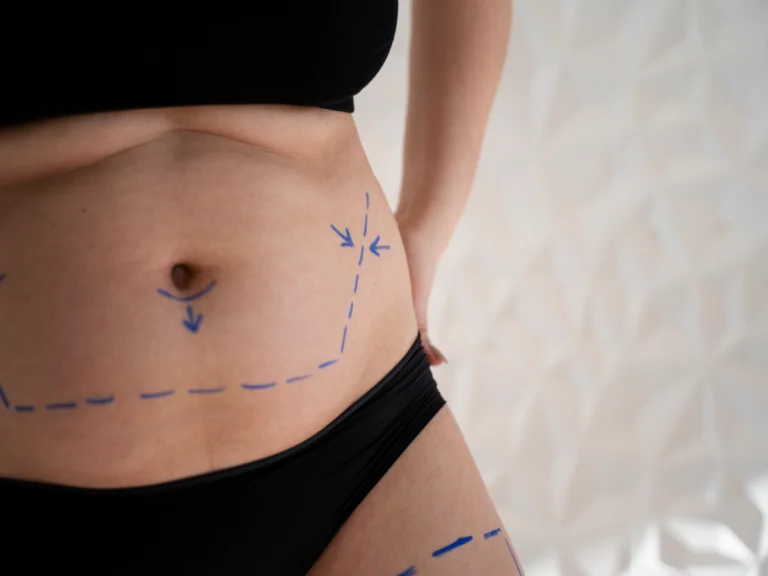Not all tummy tucks are the same. Some require more extensive surgery than others, which is why what you can expect during recovery can vary from person to person. The goal of a tummy tuck is to slim and tighten your waist for a more toned, youthful appearance, but the surgical path to achieving this goal can vary widely.
Depending on how much excess skin and fat needs to be removed, the incisions can be shorter or more extensive, including repositioning your belly button. But one of the biggest factors that affects your recovery from a tummy tuck is whether or not muscle repair is involved.
So, learn more about tummy tucks with muscle repair, how long it takes to heal, and more with Medconsulto.
Why you might need a tummy tuck with muscle repair
The abdominal muscles are called the rectus abdominis and run vertically from the sternum to the pubic bone. They have a left and right side separated in the middle by a strip of tissue called the linea alba.
The linea alba can become overstretched, usually during pregnancy, but also due to severe weight gain. When this happens, the two sides of the muscle move away from each other, causing the abdomen to bulge outward and not go away. This condition is called diastasis recti.
In addition to being a cosmetic problem for some people, this condition can affect posture and core strength. It can cause pain in the abdomen, hips and back, as well as bowel and bladder problems, all of which can have a significant impact on quality of life.
How long does it take for muscle repair to heal after tummy tuck
The difference in recovery between a tummy tuck with muscle repair and a tummy tuck without muscle repair has to do with the fact that muscles contract. Unlike the skin and fatty tissue that covers the abdomen, the muscles underneath are the main movers and stabilizers of the entire torso. This means that they contract any time you move your body. Even simple movements, such as coughing and sneezing, can engage these muscles.
When a muscle is repaired, it needs time to rest so that it can recover. Overdoing it too soon can jeopardize your results and will certainly be painful.
So, when a tummy tuck with muscle repair is included, you will be asked to be more careful and your recovery will take a little longer, three to four weeks.
Ø What is a tummy tuck without muscle repair called
Muscle repair can be very beneficial for some women, especially after pregnancy. However, if your abdominal muscles are not tight or separated, it is not necessary to include an Abdominal muscle repair tummy tuck. You can still correct a bulging abdomen and just some excess skin.
A tummy tuck without muscle repair is called a “mini tummy tuck.” It usually targets the area below the belly button rather than the entire abdomen. It can be a great fit for the right candidates.
Ø Can Muscle Repair Be Damaged After a Tummy Tuck
The tummy tuck procedure involves several steps. First, the surgeon performs liposuction to remove excess fat; this has the added benefit of supporting a smooth, precise result.
The surgeon makes an incision along the base of the abdomen, where the skin is lifted to provide access to the underlying muscles and fascia. The muscles are reattached along the midline with permanent sutures, effectively repairing the rectus muscle diastasis.
Not only does this repair typically restore the muscles to their original alignment, it also strengthens the entire abdominal wall, giving it a firm, toned appearance.
Finally, the excess skin is removed, the remaining skin is re-covered, and the belly button is shaped in its natural position on the abdominal wall.
The muscle repair not only restores the muscles to their original alignment, but it also strengthens the abdominal wall for a tighter appearance and a tighter waistline. So there is no room for damage to the abdominal muscles during a tummy tuck.
Recovery from tummy tuck with muscle repair
After muscle repair, patients often feel full more quickly when eating and feel unable to take as deep a breath as they used to. This is due to the reduced amount of space within the abdominal cavity due to the tightening of the muscles. The stomach has less room to expand and the diaphragm faces more resistance as it moves down to allow you to take a breath. Both problems, if they occur, usually resolve within four to six weeks.
Shortly after your tummy tuck, you will be given an abdominal binder to help support and strengthen the repaired muscle and reduce swelling.
You will be prohibited from lifting anything heavy for a full six to eight weeks after surgery. You will also not be allowed to do any core strengthening exercises, to avoid putting pressure on the wound and tearing it.
It is normal for all patients after a tummy tuck to have a slightly hunched posture. This is normal and it is important not to force an upright posture and over-stress the wound while it heals. This becomes even more important after muscle repair.
Ø How painful is a tummy tuck with muscle repair
Abdominal pain may feel like your stomach is being pulled when you stand up straight. The pain is most severe for the first few days after surgery. You can also take pain medication to control the pain.
Ø Tummy tuck without muscle repair after one year
After a year, the mini tummy tuck will have fully healed. The only change to expect from now on is that the scar will continue to fade and become less noticeable.
If you are considering a tummy tuck and would like to learn more about muscle repair, the Medconsulto team would be happy to provide a consultation. Please contact us now to schedule your appointment.


